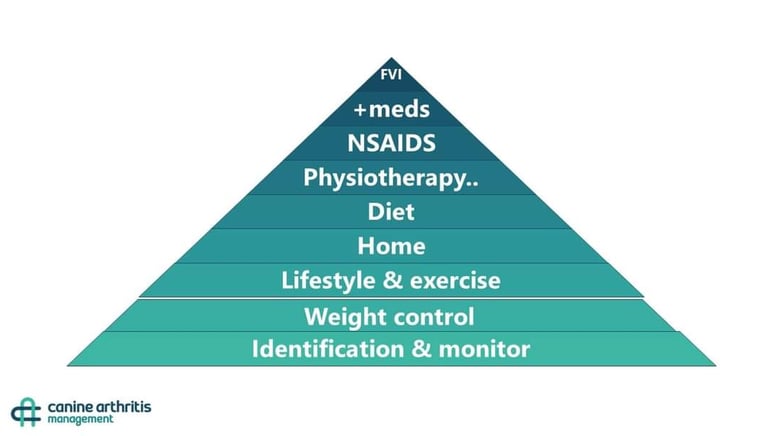Understanding Arthritis & Pain
Understanding Arthritis in Dogs
Arthritis affects the entire body and the mind.
Arthritis is Complex: Arthritis is not just a joint disease; it affects the entire body and mind.
Progressive and Incurable: Arthritis is a long-term, progressive disease that worsens over time, with pain being the primary consequence.
Most Common Form: Osteoarthritis is the most prevalent form of arthritis in dogs.
Impact on Articulating Joints: It affects joints that allow movement, supported by surrounding muscles, ligaments, and fascia.
Causes of Arthritis
Normal Forces on an Abnormal Joint: Structural abnormalities can lead to arthritis.
Abnormal Forces on a Normal Joint: Trauma or improper movement can also contribute.
Combination of Both: Often, arthritis is secondary to other conditions, like trauma or developmental issues.
Conditions Leading to Osteoarthritis (OA)
Hip and elbow dysplasia
Patella luxation
Cruciate ligament tears
Delayed growth plate closure in puppies
Trauma or injury
Arthritis Prevalence and Impact
Prevalence: Arthritis affects approximately:
35% of dogs over 1 year old
80% of dogs over 8 years old
3+ million dogs in the UK
Body-Wide Effects: Arthritis leads to joint degeneration, inflammatory changes, and decreased flexibility.
Joint fluid loses its nourishing properties.
Muscles, ligaments, and tendons weaken, causing instability and pain.
The body compensates by shifting weight to other joints, amplifying pain and function loss.
The Importance of Joint and Muscle Use
Lack of Use: If the dog avoids using a painful joint, it weakens, and proprioception declines, making the dog more prone to stumbling and falls.
Weight Redistribution: Pain and instability force the dog to shift weight to other areas, impacting additional joints and causing systemic issues.
Understanding Pain in Arthritis
Arthritis pain requires a comprehensive management approach, including:
Medications
Weight management
Physical therapy and exercise modification
Lifestyle changes
Home adaptations
Enrichment and supplements




Definition: Pain is a sensory or emotional experience associated with potential or actual damage within the body
Pain Components:
Sensory: Identifies the pain's location and possible cause.
Physiological: The body’s response, like increased heart rate.
Cognitive: The dog's understanding, e.g., whether pain will persist.
Affective: The emotional response, including anxiety and stress.
Behavioral: Coping strategies to avoid or manage pain.
Pain Types
Adaptive Pain (Acute): Short-term, protective pain that promotes tissue healing and alerts the dog to avoid injury.
Maladaptive Pain (Chronic): Persistent pain without purpose, often lasting beyond normal healing time and due to nervous system changes. Chronic pain leads to behavioral and physiological adaptations.
Spread of Pain: Arthritis pain starts at the affected joint but can radiate to surrounding areas due to inflammation.
Nociceptive Pain: Caused by direct damage, such as joint wear in arthritis.
Neuropathic Pain: Results from nervous system issues, like nerve compression.
Recognizing Pain in Dogs
Dogs often mask pain, but if the reward of an activity outweighs the discomfort, they may continue despite the pain. Signs may not appear until pain becomes chronic.
Four Main Categories of Pain Indicators
Behavioral Changes: Mood shifts, licking or chewing at joints, reduced tolerance to handling, increased sleeping, noise sensitivity, pacing, and panting.
Postural Changes: Shifting weight away from painful areas, noticeable changes in posture.
Muscular and Physical Changes: Muscle loss, coat changes, increased muscle mass around compensating areas, and uneven toenail wear.
Capability Changes: Physical changes impacting movement, like difficulty with stairs or jumping onto furniture.
Tip: Gait Changes - These are hard to observe at the vet. Record a video of your dog’s movement at home to show your vet for a more accurate assessment.
Additional Signs of Pain
Vocalizations: Groaning, whimpering, or yelping.
Restlessness: Difficulty getting comfortable, sleeping pattern changes, and appetite loss.
Self-soothing: Licking or chewing at painful areas.
Pain Management and Observation
Pain is Invisible: It’s only the signs and behaviors that we observe.
Preparing for the Vet: Organize and document your observations to help your vet understand your dog’s pain.
Summary
Dogs may continue activities despite pain; signs of pain can vary widely.
Pain signs fall into four categories: behavioral, postural, muscular/physical, and capability/gait changes.
Your observations as an owner are essential in identifying and managing pain effectively for a better quality of life for your dog.
What Is Pain?

